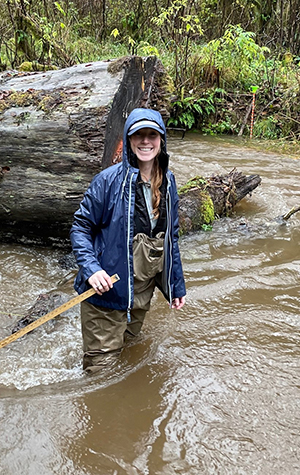OSU College of Forestry researcher is investigating whether log jams create lasting salmon habitat in the coast range

When winter and the rainier months hit Oregon, the rivers and streams around the state can really start flowing – and waterways can turn into a tough environment for small fish like juvenile coho salmon.
These fish need a safe place to live for the winter months, where they won’t get swept away by rapid flows – and Catalina Segura, an associate professor in forest engineering, resources, and management and the Fisher Family Faculty Fellow, is investigating the effectiveness of large wood restoration projects to create good habitat for these fish – and if they can offer a lasting solution for coho salmon.
Segura started this project back in 2014, just few weeks after she joined the College of Forestry. At the time, the Oregon Watershed Enhancement Board (OWEB) was working to restore salmon habitat in the Oregon coast range. To do this, they installed approximately 35 large log jams on tributaries of the Siletz River to create winter habitat for coho salmon. The log jams help slow down the flow and create calmer pools of water for the salmon to live in during the wetter months.
Segura launched a research project to investigate how this effort was changing the conditions of the streams – and whether it was actually helping create good habitat for coho salmon. Along with graduate student Russell Bair, she analyzed the conditions of the streams before and after the log jams were installed and quantified the created of new habitat for small salmon during high winter flows.
To conduct this kind of field work involves collecting a lot of data, she says. Segura’s team has collected thousands of survey points about the topography of the streambeds, the size and placement of large wood, the velocity of the water, and the existence of salmon habitat. The various iterations of this project have been a great training ground for students, she says, as she’s been able to involve and mentor many graduate and undergraduate students in this field work over the years.
Through the first round of field work and data analysis, Segura discovered that the restoration work had, in fact, increased salmon habitat – by about 30 percent.
“This finding was important and offers applicable takeaways to stream restoration efforts throughout the Pacific Northwest,” she said.
But, her work was not done. After reaching that finding, she started to ask a new set of research questions about the sustainability of the restoration efforts – and how lasting the habitats might be.
“I wanted to know what would happen to this effort over time,” she said. “How sustainable would this change be? How long would this change last?”

Her current iteration of the project is probing that line of questions. Along with graduate student Madelyn Maffia, she’s measuring the current state of the streams for salmon habitat. She wants to find out if that 30 percent number has gone up or down over the last few years – which could hold important implications for future restoration efforts.
“It’s important to know this information when thinking about how to restore rivers because ultimately there aren’t enough resources to restore every mile of river,” she explained. “This will help decision-makers understand the most effective places to invest resources to restore waterways and create salmon habitat.”
Creating safe habitat for the coho salmon is important because coho salmon have been on and off of the endangered species list for years – and coho salmon hold great economic, cultural, and environmental significance. Salmon has been a vital food for Tribes in Oregon for thousands of years and is still a meaningful cultural symbol for tribes, including the Confederated Tribes of Siletz Indians, whose Tribal land overlaps with part of Segura’s research site. Some of Segura’s work was supported by the Spirit Mountain Community Fund, which is organized by the Confederated Tribes of Grand Ronde.
The project is ongoing and keeps growing. She’s currently partnering with the Oregon Department of Fish and Wildlife (ODFW) to assess how her findings about the restoration projects and hydraulic changes line-up with ODFW’s research into the health of coho salmon. “We want to see how our assessment of geomorphic changes compares to their biological metrics for salmon,” she said. “Collaborating on this assessment will allow us to uncover a richer story about how successful this kind of restoration efforts are.”


I like how you mentioned that salmon would find a safe space during the wintertime to avoid sweeping by the rapid flow of water. My spouse told me the other day that she wants to experience a salmon fishing trip for her birthday next week for the first time. She asked if I had any idea what would be the best option for a great experience. Thanks to this helpful article, I’ll tell her that I will consult salmon fishing charter services as they can provide more information about their rates and services.